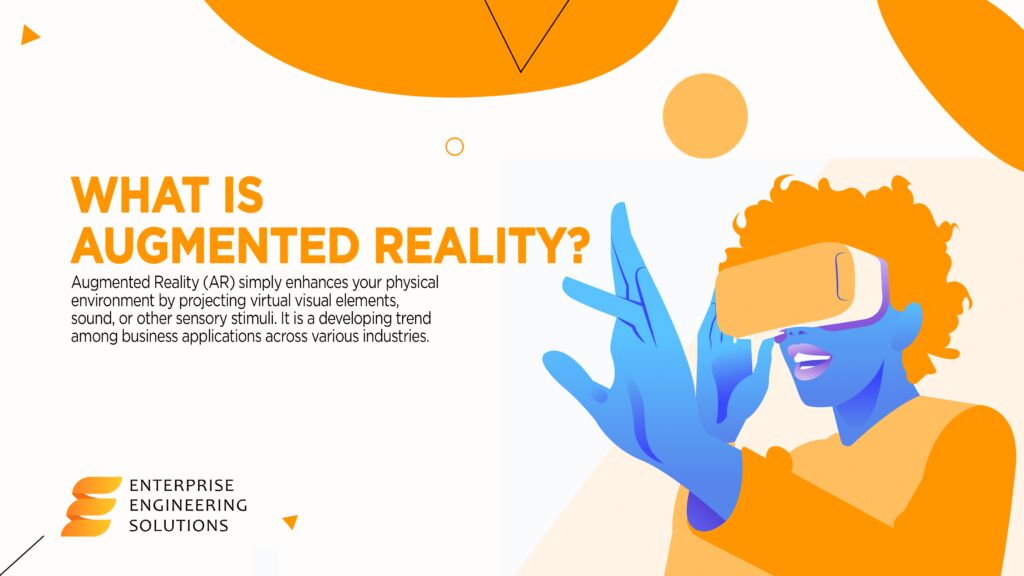What is Virtual Reality?

Virtual Reality uses digital tools such as display and audio to build simulated environments. Its places the user in a 3-dimensional virtual environment. It substitutes your screen with an interactive 3D world that simulates human senses. VR turns digital devices into multi-dimensional platform simulators.
However, developers may be facing the dilemma of computing power and content availability.
What is Augmented Reality?
Augmented Reality (AR) simply enhances your physical environment by projecting virtual visual elements, sound, or other sensory stimuli. It is a developing trend among business applications across various industries.
What is Mixed Reality?
Mixed Reality blends factors of both AR and VR to provide a simplified but unique experience. Unlike virtual and augmented reality services, which help you view virtual content using a filter or app, mixed Reality enables interplay with the digital content. You can use gestures to transport a piece of digital content around a digital whiteboard and notice virtual avatars of your colleagues sitting beside you.
Augmented Reality vs Virtual Reality vs Mixed Reality
The three fundamental classes of virtual reality development services include:
Non-Immersive Virtual Reality
This category usually gets left out of “VR,” sincerely because it’s not unusual. Non-immersive VR includes a computer-generated environment where you simultaneously remain aware and manage your physical surroundings. Video video games are a top example of non-immersive VR.
Semi-Immersive Virtual Reality
This type of VR presents partial-virtual surroundings. It’s familiar among academic and educational applications that use graphical computing and massive projectors, such as flight simulators for pilots.
Fully Immersive VR
This form of VR generates the most realistic simulation, from sight to sound to some sensations. Car racing video games serve as good examples of immersive VR, giving you the sensation of velocity and using skills. Development for more gaming and other uses in different sectors is ongoing.
Understanding Augmented Reality Solutions
- Augmented reality use is snowballing across various sectors.
- Early adopters in the retail sector have used AR to enrich the client shopping experience. Customers can visualize exclusive merchandise in particular environments by incorporating augmented Reality into catalog apps.
- Customers point the digital camera to the fitting room for fixtures, and the product appears in the foreground.
- Its uses are also spilling over to healthcare for more extensive functions. One way would be via apps that permit users to see surprisingly detailed, 3-D depictions of different frame structures when they hover their device over a target photograph.
- Augmented Reality may be a powerful tool in helping medical experts collect information and gain knowledge throughout their training.
- Wearable devices will surely take virtual and augmented reality services a step forward. Whereas smartphones and other displays show a tiny part of the consumer’s panorama, smart eyewear, for instance, may also provide a more significant link between physical and digital environments.
Some Business Use-case For AR and Virtual Reality Development Services Include:
- Real Estate: Designers are given a brilliant opportunity to experience more than just three-D models for simulating the live interior of their buildings. Also, real estate agents can use AR and VR to show possible tenants detailed views of different properties.
- Healthcare: It offers various healthcare benefits that cover health practitioners, academics or medical researchers, and patients. You can suppose the use of VR and AR to relax anxious patients or ease the mood of depressed individuals by distracting them from Reality. Medical students will be able to learn more efficiently, most importantly, about surgical training through real-life imaging.
- Retail: Retailers will be able to offer real-time imagination to customers to position themselves in situations where they can “try on” garments or gadgets to get a realistic feel before purchasing.
- Entertainment: Mesmerizing experiences will rework leisure. Gaming and Hollywood will allow customers and viewers to move from passive to energetic. Consumers will interact with services in a customized way (must they want to). Choosing your own POV in games will preserve to offer new sorts of engagement.
- Data Visualization: Engineering and clinical data visualization have profited for years from VR. The new display era has revolutionalized weather models, molecular visualization, and other data visualization models.
- Fashion: You can view Dior’s VR save on its French internet site. It offers shoppers a 3-D, 360-degree e-commerce experience. Users can genuinely browse the store’s offerings, zoom in on desired items and purchase them online.
- Manufacturing: Designers and engineers can experiment with different models of products and test looks before commissioning high-priced prototypes. Brands including Jaguar and BMW use the generation for early layout and engineering reviews. Virtual Reality saves the car enterprise millions by decreasing the variety of prototypes built according to automobile lines.
- Law Enforcement: VR goggles are revolutionizing digital training and can help improve law enforcement training. Incident schooling is possible, enabling adequate preparation of officials for everyday situations.
The Future of Business with These Technologies
Businesses can use these three technologies to build competitive advantages and improve customer interactions, considering both technologies are developed thoroughly and remain user-friendly.
You can imagine the massive potential in sales and retail. While the opportunities of MR are nonetheless under observance, the mixture of digital and real-world environments promises interesting matters for the future.
Mixed Reality is likely to be a treasured tool for on-the-task training, thanks to the mixture of practical education and virtual statistics. It may be the key to supporting interactive communications between teams and clients in the collaboration surroundings. These technologies will allow businesses to communicate effectively, work on shared thoughts, and build virtual prototypes in real-time.





